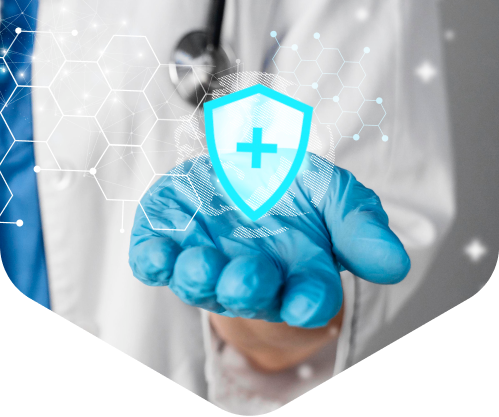5 Technology Challenges in Healthcare
If you’re an IT professional in the medical industry, you’ve got more than your fair share of healthcare IT challenges.
You’re figuring out how to comply with regulatory and legislative mandates, battling security threats, and dealing with changes resulting from new technology—all while being pressured to reduce costs.
Your IT team is stretched to the limit. Your system is straining under increasing demand. You’re making progress, but sometimes it feels like you’re taking one step forward and two steps back. And now the hospital wants you to add AI to the mix.
No one would argue with the importance of information technology in healthcare. Modern hospitals would barely be able to function without their IT infrastructure.
And yet, healthcare IT teams are rarely given the resources they need to meet an ever-increasing list of technology healthcare industry demands.
One cost-effective way to address the technology challenges in healthcare is to partner with a third-party software development company. Let’s look at five healthcare IT challenges you can overcome within a year with help from a reliable development partner.
Interoperability
One of the biggest challenges of technology in healthcare is interoperability. As part of federal healthcare mandates, your organization must be able to keep patient data secure while also sharing it quickly with care teams. And not just your internal teams.
According to the Healthcare Information and Management Systems Society (HIMSS), the scope of interoperability in healthcare includes “the ability of different information systems, devices and applications (systems) to access, exchange, integrate and cooperatively use data in a coordinated manner, within and across organizational, regional and national boundaries, to provide timely and seamless portability of information and optimize the health of individuals and populations globally.”
In other words, your healthcare organization must be able to exchange a patient’s information with other healthcare providers anywhere in the world.
And a Deloitte survey showed that physicians expect to push interoperability even further. They see electronic health record (EHR) interoperability becoming a standard practice in care delivery over the next decade, and not just for hospital systems.
Big Data
Doctors also expect interoperability to include patient health data from wearable devices and consumer apps. That’s a lot of data flowing into your system, adding to the already massive amount of information you’re currently dealing with.
According to a report by Healthbox, Healthcare’s big data can be boiled down to four principal “Vs”—Volume, Velocity, Variety, and Validity.
Payers, providers, labs, pharmacies, and other healthcare organizations generate a massive volume of patient data. So do sensors, smartphones, medical devices, and wearables. With this data being provided in real time, the velocity bombards you with valuable information faster than you can make sense of it. The variety of data adds to interoperability issues, while also making it difficult to validate the accuracy of the information.
Bottom line: It’s a challenge not only to access and store all that patient information, but also to convert it into meaningful insights.
The good news? New technologies can help you keep up. Artificial intelligence (AI), machine learning (ML), and other solutions can work hand-in-glove with clinicians to interpret the flood of patient data and use it to achieve better health outcomes.
Data Security
While interoperability and big data issues loom large, the towering concern you must defend against is the threat to patient data.
Cyberattacks against health systems occur with alarming frequency. According to IT security firm Sophos, 34% of healthcare organizations were hit by ransomware in the last year.
The average cost of a ransomware attack, Sophos reported, was $1.27 million. That figure includes downtime, personnel hours spent, device expenditures, network costs, lost opportunities, ransom paid, and other expenses.
The worst part? On average, organizations that resorted to paying the ransom had only 69% of their data returned in an accessible form.
Ransomware is only one threat to health data. Other forms of malware are still a recurring problem for health systems. Your IT team still must defend against viruses, worms, trojan horses, and other security gap exploitations.
Outdated Technology
An outdated IT infrastructure hinders your efforts to overcome interoperability, big data, and data security challenges. Healthcare systems already strain under an increasing load of bandwidth-intensive connected devices, according to HIT Infrastructure.
And that’s just one stressor. Adding in the software to needed to effectively process big data, for example, may push your outdated system to the breaking point.
But updating the system can also present challenges. Your legacy systems may not interface easily with newer software solutions, and yet are often too expensive to replace.
Custom application programming interfaces (APIs) and other workarounds can be built to connect modern software with legacy systems in some cases—but that adds work to your already overburdened IT team.
Competitive Advantage
While contending with those four big technology challenges in healthcare, you still have to compete with other healthcare systems in your area. Delivering high-quality care is the number one way to attract patients, but there are technology factors at play, too.
Some bits of technology healthcare industry businesses use to gain a competitive advantage include:
- Telehealth
- Electronic health records (EHR) and electronic medical records (EMR)
- Mobile health (mHealth) apps
- Business Intelligence (BI)
- Interactive patient portals
- Pharmacy management
- Nextgen Connect
- E-prescribing
- Health information exchange (HIE)
Healthcare organizations use these technologies to increase patient engagement, comply with value-based care initiatives, streamline operations, and improve quality of care.
But with IT teams already overwhelmed by other challenges of technology in healthcare, implementing new solutions can get pushed down in priority. As a result, you might lose business to competitors who can put these systems in place.
Overcoming Technology Challenges
So how can you overcome these healthcare IT challenges?
The obvious answer is to increase the size of your IT team, but there are two problems with this approach.
First, it’s slow. You have to get the budget approved, go through the hiring process, and get the new team members up to speed before the work can even begin. And that might take months.
Second, it may not be cost-effective. Depending on how many challenges of technology in healthcare you need to address, and the time frame in which you need the work completed, you may need to double or even triple the size of your IT team.
If you find yourself in this situation, the better solution may be to partner with a software development company.
Third-Party Healthcare Software Development
Software development companies offer a fast, efficient way to overcome your most pressing technology challenges. The right partner can consult with you on the best way to solve your problems, design effective solutions to those problems, develop them quickly, and even help you maintain the new systems.
Teams that have developed healthcare software before have the deep experience needed to create stable, scalable, secure solutions that meet or exceed the latest healthcare industry regulations.
An experienced team will also know and follow all regulatory standards and privacy laws. They’ll have in place the internal checks and balances mandated by the US Department of Health and Human Services (HHS), the Health Insurance Portability and Accountability Act (HIPAA), the Health Information Technology for Economic and Clinical Health (HITECH) Act, and the Medicare Access and Children’s Health Insurance Program Re-authorization Act of 2015 (MACRA).
Deep healthcare experience combined with a sole focus on development allows third-party software development companies to solve your healthcare technology challenges fast and free up your internal IT team for other critical tasks.
Leap Forward
With help from a healthcare software development company, you can go from “one step forward, two steps back” to moving forward in leaps and bounds.
Taazaa is here to help you. With Taazaa, you get:
- Healthcare specific UI & UX
- Streamlined clinical workflows
- Healthcare compliance (HIPAA, HITECH, MACRA)
- Hybrid development approach
- Interoperability through seamless data transfer
- Robust and secure systems
Our healthcare consulting, design, development, and maintenance services provide unmatched value and expertise in the technology healthcare industry organizations need. Just ask the Cleveland Clinic Foundation, Emvitals, the Matrix Medical Network, and our other healthcare customers.
Our custom healthcare solutions help hospitals, clinics, and other care providers with improved patient outcomes, reduced costs, and value-based care.
Not only do you get quantifiable business results, but we also design all of our solutions to be easy for your patients and staff to use.
Want to learn more? Give us a buzz.


